Rio Lagartos
An interesting alternative to the Celestun wildlife reserve visit is to Rio Lagartos. Northeast of Merida. It takes a much longer drive but it is absolutely worthwhile. As in many places in our beloved county, the name of the village is not accurate on may accounts; first, it is not a river (rio), there are non in the Yucatan peninsula, but a ria, which is sort of an estuary. Second there are no Lagartos (alligators), we have crocodiles (no need to translate). As in Celestún, you will be able to spot many bird, species (flamingoes included). The big plus are the salt flats at Las Coloradas (next to the salt company site); beautiful pink ponds making a dramatic contrast with the blue skies. Our recommendation: go see for yourselves !
Yucatan Sisal Plantations
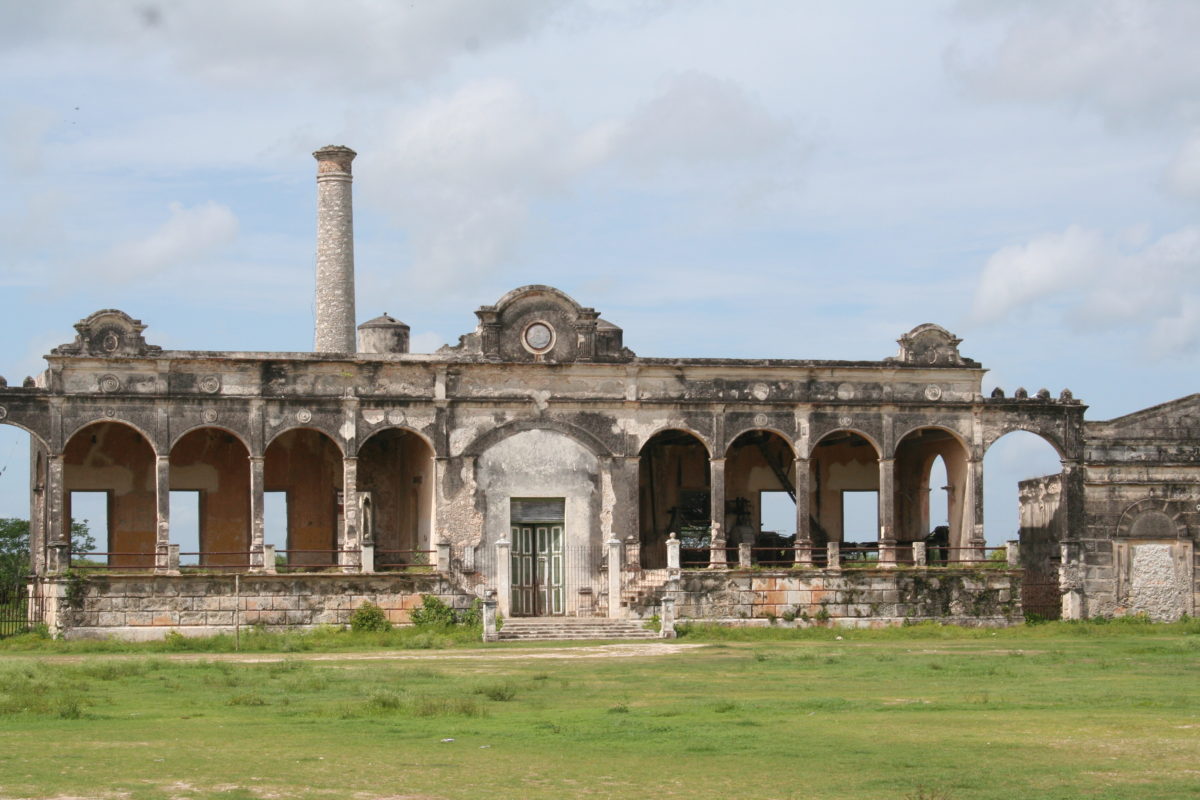
A common stop among Yucatan visitors is at the hacienda “henequenera”, or sisal plantation. Not visiting an Hacienda while in Merida, is like skipping Notre Dame in Paris or Central Park in NYC. Some of our US visitors say that our “henequén” or sisal also goes by the name of hemp or twine.
You can literally count a hacienda or two by town, village, or municipality in (mostly) central Yucatán state. The list of hacienda can seem endless, and many of them are just a mount of rubble. At our facebook page you can find images of Uayalceh, Yaxcopoil and Mucuyche, all of them at different stages of disrepair, but still giving an idea of what they once were
A bit of history on the sisal plantation…….
Haciendas of Yucatán were agricultural organizations that emerged primarily in the 18th century. They had a late onset in Yucatán compared with the rest of Mexico because of geographical, ecological and economic reasons, particularly the poor quality of the soil and lack of water to irrigate farms. Commonly the farms were initially used exclusively for cattle ranching, with a low density of labor, becoming over time maize-growing estates in the north and sugar plantations in the south, before finally becoming henequen estates.
“Haciendas henequeneras” refers to estates in the Yucatán which were created during the 19th century when the henequen industry debuted. The hacienda henequenera required large staffing for the cultivation of the fields, as well as, the development and maintenance of industrial processes, such as defibrating the leaves. One of the regions of Yucatán which had produced maize but evolved into the henequen industry is the area adjoining and near to Mérida. Along the main roads and in the “camino real” between Campeche and Mérida, these haciendas became established. By the 19th century, the hacienda henequenera developed on a wider scale throughout Yucatán, particularly in the north-central region, where the soil was better suited for the cultivation of henequen.
Henequen boom
Previous to the emergence of the henequen industry, landowners lived in Mérida and treated their landholdings as occasional retreats. With the emergence of henequen and the wealth it produced, the farms were transformed into haciendas which typically had a grand manor house, the machine house, and a chapel. Because a large population was needed to take care of the properties, workers were provided with housing and the amenities of a community. The foreman usually has his own home, and there were storage buildings, the hydraulics or pump house, a school, an infirmary, a store, the stables and a jail.]
Servants on the estates lived in a situation that was very similar to that of the bonded serfdom of the peasants of medieval Europe. They were not slaves, as they retained some civil rights, but they were not free, as they were bound to the land, forced to serve against their will, and in the absence of any type of currency at the governmental level were paid in hacienda tokens. These coins were issued by the hacienda owners to pay workers, but could only be exchanged for goods on the hacienda or at the “company store”. As there were perpetual labor shortages, indentured servants were also brought in from China, Korea and the Canary Islands. In addition to their cultivation of the fields, workers were required to provide unpaid labor for the tasks necessary to keep the hacienda running.
The era of the henequen boom from the late 1800s to the early 1900s was known as the time of “green gold”.[8] At the height of the boom, there were nearly 1,200 haciendas within an 80 km radius around the city of Mérida. The haciendas changed the development of Mérida, as many of them became what are neighborhoods of the city. Hacienda San Cosme is now Colonia García Ginerés; Hacienda Tecoh covered what now makes up Colonia San José Tecoh, Colonia Castilla Cámara, Colonia Mercedes Barrera, Cinco Colonias and the Fraccionamiento Zacil Ha; Hacienda San Isidro is now Colonia Melitón Salazar; Hacienda San Diego Azcorra is now Colonia Azcorra, Colonia Miraflores, Colonia Unidad Habitacional Morelos, Colonia Morelos Oriente and Colonia Salvador Alvarado Sur; Hacienda Wallis is now Colonia Chuminópolis and Colonia La Esperanza; Haciendas Petcanché and Hacienda Chichí Suárez are now Colonia Jesús Carranza, Colonia Miguel Alemán, and Colonia Chichí Suárez, just to name a few.
Pirates in Campeche
Pirates and piracy as a conversation topic goes from high to low depending on the releases of the Pirates of the Caribbean saga. Taking out the formidable sea creatures, invincible vessels and outrageous bounties, there was indeed significant pirate activity for more than 200 years in this part of Mexico and the Caribbean.
A not well-known pirate, yet (sadly) effective…..
Christopher Myngs became subcommander of the English naval flotilla based in Jamaica and by 1658 he was promoted to full commander acting as what the English called a “commerce raider.” As a “commerce raider” Myngs led English naval vessels and ships manned by buccaneers to attack Spanish galleons and merchant vessels and he led a series of brutal attacks on Spanish settlements throughout the Caribbean. Most English pirates / privateers had veiled or sometimes outright support from the English crown to attack Spanish vessels, their long-time enemies throughout many stages in history, to undermine Spanish power in the region.
After the Anglo-Spanish War had ended, England still had plans to expand its possessions in the Caribbean and parts of the mainland of the Americas, and the Crown wanted Myngs to continue his strategy of employing pirates to assist him in attacking Spanish ships and towns, to seize wealth and destroy infrastructure. By the end of 1662, Myngs and his small fleet of pirate ships attacked the heavily fortified city of Santiago de Cuba, a settlement on the southern part of the island of Cuba founded by the Spanish in 1515. The English commander made good on his promise and shared the wealth he plundered from Cuba with the pirates who helped him. After his Cuban victory Christopher Myngs announced a daring plan to sack the Spanish city of San Francisco de Campeche, now the capital of the Mexican state of Campeche, a somewhat unprotected but very wealthy town in the western Yucatán on the Gulf of Mexico. As news of Myngs’ attack on Santiago de Cuba spread throughout the Caribbean, he had no problem recruiting pirate volunteers from all parts of the region for his planned assault on Campeche. When the attack fleet gathered at Port Royal, Jamaica – including ships of French and Dutch privateers – it was the largest contingent of pirates ever assembled. Myngs would command over 1,400 pirates on over 20 vessels. In January of 1663, the fleet set sail for Mexico.
Soon after the Spanish conquest of the area, San Francisco de Campeche became an important port on its own unique path of development as it was located far from the centralized Spanish authority in Mexico City. As trade with the Orient increased, Campeche became a point of embarkation for Asian valuables that crossed overland after landing on Mexico’s Pacific Coast. Galleons made regular runs to Spain out of Campeche and the city grew to be a regional center for trade. By the middle of the 1600s Campeche had become one of the wealthiest cities in the Viceroyalty of New Spain, but it lacked proper defenses which made it subject to small pirate raids and petty attacks from ships of other European powers. Famous pirates and privateers such as Sir Francis Drake, John Hawkins and Jean Lafitte had their runs at attacking Campeche, but nothing was to prepare the city for the huge armada of pirates which amassed at Jamaica in January of 1663.
The pirate raid on Campeche had some lasting effects. The attack was so severe that the king of England, Charles the Second, forbade all future military adventures involving English naval officers and pirates. The city of Campeche rebuilt itself, and the Spanish, realizing the need for better fortifications invested in massive defensive works for the city. Work began in 1686 and would be finished decades later. French architect Louis Bouchard de Becour was hired to unify the fortifications and to supervise building the 2,650-meter-long wall which enclosed the city in an irregular hexagonal shape. At the corners of the hexagon were 8 defensive bastions named after saints or religious figures. The wall had two gates, a sea gate and a land gate. Two small forts were also built on hills outside the city. The beefed-up defenses did the trick and Campeche enjoyed a peaceful existence for most of the rest of its history. Many of the fortifications built in the 17th and 18th Centuries still survive to this day and are well preserved. The preservation of the parts of the city from the pirate era earned Campeche the status of a UNESCO World Heritage Site in 1999. And what of the 1,400 pirates who took part in the Sack of Campeche? Many of them gained valuable experience and continued their careers as pirates on the open seas or as mercenary fighters for foreign governments. Many took their Mexican loot and settled down in England or made new lives for themselves in the recently-founded English colonies on the eastern shores of North America. Some set up little colonies of their own in the Caribbean region settling in places like the Mosquito Coast, the Bay Islands and the modern nation of Belize. Many descendants of these pirates still live in these areas today. Over 350 years after the raid on Campeche the pirate stories and legends survive in popular culture and continue to evoke feelings of adventure and romance.
Merida in motion
Merida is amongst the oldest cities in Mexico (not as old as Campeche, also in the Yucatan) so there are a significant number of old colonial building – our Spanish heritage- , from Franciscan churches to stately family homes. Sadly, the “modern” Spanish settlement was built by tearing down the old Mayan temples from T’ho (a regular practice in those early days).
Having no architectural background, I have seen significant changes over the past decade. Walking around the broader downtown area, you can see how present day Merida is blending modern architecture with the buildings from the colonial times. Symbols or elements from our cultural past are present in the newer building, the most striking example is the pattern or lattice work on the new Paseo 60 building that represents the leaves of the “henequen” plant (or sisal).
Another example of harmony is the new Palacio de la Musica, for which the horrendous “modern” and former house of deputies was torn down, just behind the Tercera orden baroque church. The house of deputies lacked proportions, grace and everything else, while the new museum ensures a smooth transition from 21st. century architecture to the baroque of the 18th. century.
Likewise, the new convention center embraces a typical family home from the late 19th century and does not look out of place. Walk around the city, you will find many pleasant surprises.
Merida old railway station
The Merida railway station is located on Calle 55 between 48 and 46, not too far from downtown proper. Since passenger rail services stopped in 1997, this neo-Colonial building has been renovated and now houses an art institute, the Escuela Superior de Artes de Yucatan.
It is one of the best preserved buildings of its kind and is for this reason worth seeing. The ornate architectural details reflect Moorish influences, and the central tower is especially noteworthy. The old (and only) train station in the city was built between 1913 and 1920 by the English architect Charles J.S. Hall, and is considered perhaps the only example in Merida of the neocolonial style promoted by the government at the time. Not much else can be researched about both the construction and the architect himself.
This building was restored by the state government in 2007 to house the state art school. In spite of the significant improvement, these past +10 years are showing the lack of adequate upkeep, unfortunately.
The future plan for the large land extension is to create a park. The residents of this area, known as La Plancha district have been campaigning to see this project thru.
Gran Parque La Plancha is the concept to transform the 60-acre field behind them into a public park. Proponents call the park a potential “green lung” where young and old can meet for exercise, take a walk or just relax with family and friends. The site is a rarity for the crowded Centro — a massive open space. Between Calles 55 and 43, and Calles 48 and 46, the site would appear perfectly positioned to become a forested park with walking paths, botanical and community gardens, playing fields, and a bicycle lane. A local resident estimates about that +200 expats now live in the area.
The federally owned parcel is tied up in a dispute between the government and a former railroad concession holder.
Uayma
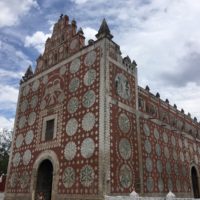
Uayma is often bypassed by Valladolid visitors, in spite of it’s proximity (a 10 minute drive). The town does not have the “pueblo mágico” distinction, but it is definitely worth a visit.
Uayma is a small town located in the center of the Yucatán Peninsula, about 15 kilometers north and west of Valladolid. In colonial times Uayma was a major stop on the El Camino Real between Merida and Valladolid (the third largest city in the state).
The striking landmark is the church – a former Santo Domingo de Guzmán convent, originally built by the Spaniards to enforce their culture in Uayma, which was at the time an important Mayan center. Stones from nearby Mayan structures were used to build the church (a common practice across the region), some of which can be seen on the facade. Building started around 1646, but it was destroyed in the 19th century during the Guerra de Castas (caste war). Other colonial structures and more recently built structures, including a railway station, remain in various states of disrepair around the town.
Renovation of the town’s unique church was completed in 2005. Restoration was completed due to the efforts of Elba Villareal de Garcia Ponce and Fernando Garces Fierros, through both a private program called Adopte una Obra de Arte (Adopt a Work of Art) and the government’s Institute of Anthropology and History, or INAH.
There is no accurate data on when the town was founded, though it existed before La Conquista (the conquest) and in antiquity belonged to the chieftainship of Cupules. During colonial times, Uayma became part of the encomienda system (a disguised slavery-type system) with the first recorded encomendero as Juan Bellido 1549-1579.
Chayanne in Merida – Promo
You can find a series of videos of a top charts song by Chayanne, with multiple background Yucatan settings. This particular one was shot at the central railway station, Yaxcopoil hacienda and what look like the cenote at San Antonio Mulix near Cacao.
Itzimná
In the location of the temple of the Maya god Itzamná, the Spanish conquistadors erected a small chapel in 1572 where the baptismal font is still preserved. Later, in 1710 they built the temple that is still being preserved. For years, Christ of Esquipulas was revered here and it was dedicated to St. Michael the Archangel until 1944. It stands in a plaza between lush trees and manicured gardens, and it is an example of the Franciscan architecture of the sixteenth century. Currently, historic Itzimná is one of the most beautiful and traditional areas of the city of Merida and its parish is the most active of the Archdiocese of Yucatán.
García Ginerés Neighborhood
Colonia García Ginerés in Merida
Originally this area was the land of a hacienda called “Datil y Limón” (Date and Lemon), located far outside of Merida. In the late 19th Century, the hacienda was bought by Don Cosme Angel Villajuana and named San Cosme after himself and his patron saint. In 1904, a Spaniard with real estate acumen, bought the hacienda from Don Cosme, partitioned it and sold the lots. His name was Señor Don Joaquín García Ginerés, and when he died in 1915, the area was named after him. When Don Joaquín first started selling these plots, people were afraid to buy so far out of town. Joanna Rosado, author of ´Tomando agua del pozo¨, tells how when she moved to Merida in the 1960s, García Ginerés was still far out of town and crisscrossed by dirt roads.
Today, García Ginerés is a mostly residential area, cut down the middle by the busy, one-way Avenida Colón. The streets are wide, and the houses are a mixture of old and new, though most are less than fifty years old. There are elegant expensive homes and cheaper less grand houses as well, but in general, the area is an upper middle class enclave. In the physical and cultural center of the colonia, at the corner of Calle 20 and Avenida Colón and Calle 20, is Parque de Las Americas, a tree-filled park in four quadrants that was built in a Mayan Art Deco style (also seen in the Monumento a la Patria on Paseo de Montejo) and finished in 1946.
Throughout the park are monuments to all the different countries of North and South America, in a style that pays homage to the Mayan culture in direct opposition to the area’s heritage of Spanish conquest. The park was built to represent the unity of the American people, pre-Hispanic cultures and socialist ideals. The park has a large fountain in one quadrant, a performance space with a concha (half-shell) open-air auditorium in another and the Jose Martí cultural center in a third. The fourth quadrant is fenced off and reserved as a children’s play area. Our friends have told us that there was once (and probably still is…) a cenote underneath the concha. Today, residents enjoy the park for sitting in the shade, attending cultural events, and walking or running around the perimeter for exercise. On weekends, the park is often the site of athletic or cultural events.
Trees and flowers of the Yucatan
The Flamboyan tree (Spanish, also known as Tabachín in central Mexico), Poinciana regia, Caesalpiniaceae family is endemic to Madagascar and was introduced in the late 19th Century. In Yucatan, these beautiful flowering trees became favorite ornamental trees. Itsorchid shaped deep orange-red flowers are truly exquisite, one petal is different from the rest with light tone and deep shades of orange magenta spot; flowers grow in clusters, blooms in May and summer the Flamboyan trees are fully covered with flowers without their pinnae leaflets (foliage). Flamboyan seeds grow in large hard pods.
Another favorite in the area is the Maculis or pink Uayacán. This species is distributed from southern Mexico to Venezuela and Ecuador. The tree crown is wide, with irregular, stratified ramification and only few thick branches. The bark can be gray to brown, in varying darkness and may be vertically fissured. Leaves are compund, digitate and deciduous. Each leaf has five leaflets of variable size, the middle one being the largest. Flowering occurs mainly in January and February, and is generally associated with dry periods; although flowering has also been observed in August, September, April and May. Flowers are large, in various tones of pink to purple, and appear while the tree has none, or very few, leaves. Pollination occurs probably by insects, although the flowers are visited by many birds such as tangers, hummingbirds and orioles (yuyas). The long and slender fruit capsules can measure up to 35 cm (14 in) and appear from February through April. It is a fairly fast growing tre
Also gracefully decorating many avenues and trees in Merida, the Lluvia de Oro tree (Spanish), Cassia fistula, Fabaceae family; is native to southern Asia. A deciduous tree with pinnae leaflets (foliage), brought in the late 19th Century to Yucatan as an ornamental flowering tree; it is most striking during May when it is in full bloom. Flowers bloom in delicate golden yellow drop clusters. Golden Shower seed pods are long dark brown sausage-like with woody exterior and stick molasses covering wafer shaped seeds, abundant while blooming. Like the Royal Flamboyan, Golden Shower tree is a favorite in small Mayan hamelts and Yucatan’s urban avenues or parks, for its amazingly exotic looking and has truly whimsical beautiful flowering bloom clusters gently dropping ever so graceful down its branches.

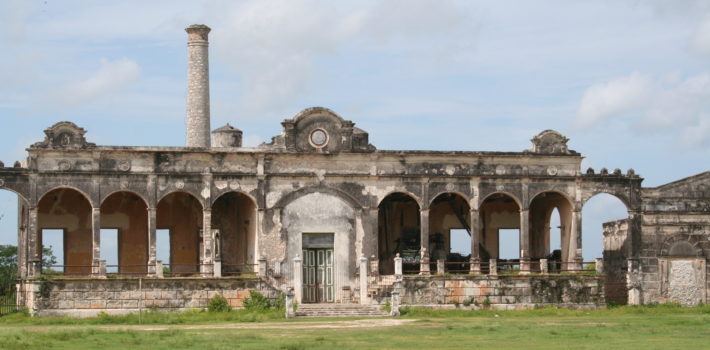

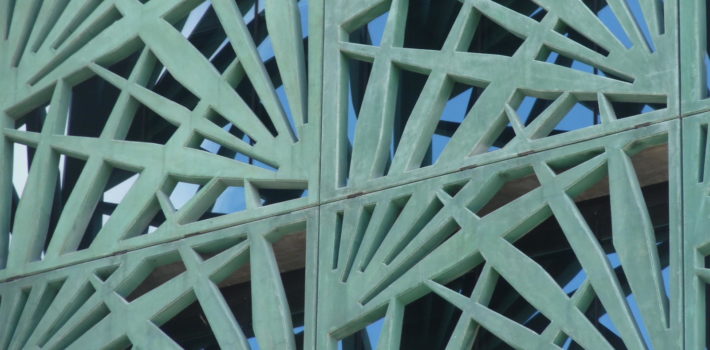

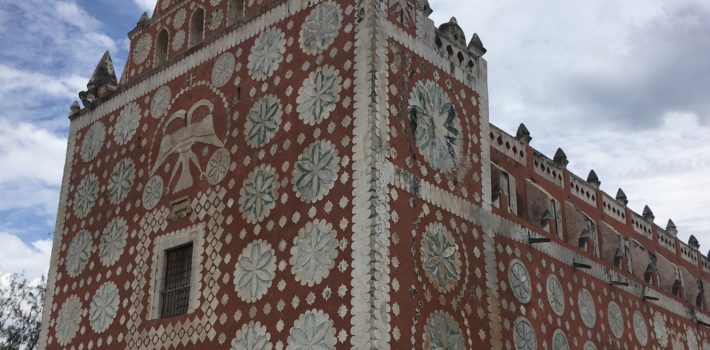


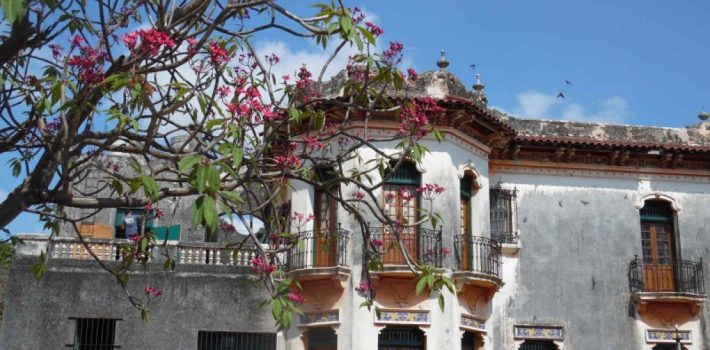

Recent Comments